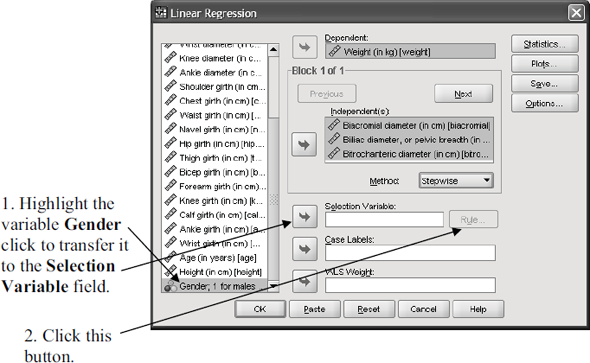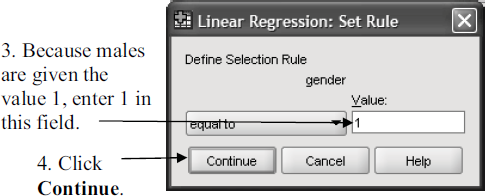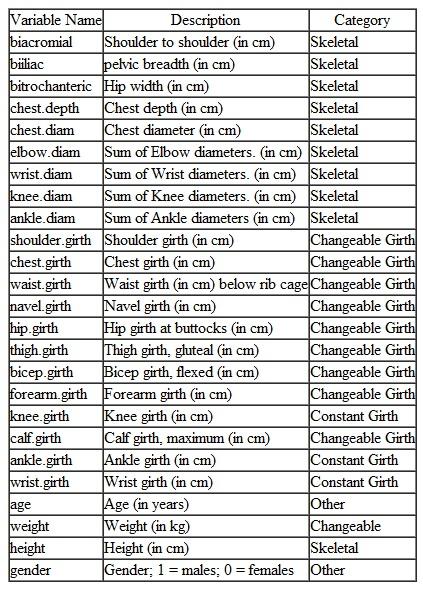
A Visual Approach to SPSS for Windows 2nd Edition by Leonard Stern
النسخة 2الرقم المعياري الدولي: 978-0205706051
A Visual Approach to SPSS for Windows 2nd Edition by Leonard Stern
النسخة 2الرقم المعياري الدولي: 978-0205706051 تمرين 5
In part 1 of Exercise 1, an equation was derived for predicting a person's weight from skeletal variables and the variable height. Now, the possibility will be explored that the equation derived from a stepwise model that predicts weight from these variables differs for males and females.
1. Use a stepwise method to derive an equation that predicts a male's weight from the skeletal variables and the variable height. The data of just the males can be selected from within the Regression procedure. The steps shown below illustrate the procedure:


What is the equation How well does it explain variability in weight
2. Repeat part 1 this time analyzing just the data of the females. What is the equation How well does it explain variability in weight
3. Derive an equation to predict weight from the chest girth, hip girth, and height for your gender. Use a tape measure to determine your own chest girth (above breast for females, at nipple level for males) and your hip girth (largest girth over buttocks). Insert these girths and your height in the equation to predict your current weight. Does your current weight fall within the standard error of estimate of the predicted weight
Exercise 1
Heinz and Peterson measured the body characteristics of healthy, active adults. Ten of the measurements, including height, were of skeletal properties that could be used to define each person's body build. Twelve measurements were of girths that either were changeable (they could be affected, for example, by how much muscle or fat a person had) or constant. In addition, each person's weight was measured. Age and gender were recorded. The variables' names and each one's category are shown in the table below:
 These data are available on the publisher's website for this text at the address http://www.pearsonhighered.com/stern2e in the file BodyDimensions.sav. This dataset is adapted from data published in the article by Heinz, Grete, Peterson, Louis J., Johnson, Roger W., and Kerk, Carter J. (2003), "Exploring relationships in body dimensions", Journal of Statistics Education Volume 11, Number 2, www.amstat.org/publications/jse/v11n2/datasets.heinz.html. Full measurement descriptions are given in this article. Permission to use the data has been granted by the authors.
These data are available on the publisher's website for this text at the address http://www.pearsonhighered.com/stern2e in the file BodyDimensions.sav. This dataset is adapted from data published in the article by Heinz, Grete, Peterson, Louis J., Johnson, Roger W., and Kerk, Carter J. (2003), "Exploring relationships in body dimensions", Journal of Statistics Education Volume 11, Number 2, www.amstat.org/publications/jse/v11n2/datasets.heinz.html. Full measurement descriptions are given in this article. Permission to use the data has been granted by the authors.
1. What is the equation that predicts a person's weight from the skeletal variables including the variable height
2. How well does the equation derived in question 1 explain variability in weight Is the relation statistically significant Provide supporting data.
3. Create a prediction equation for weight from the changeable girths and height. Does it predict weight more accurately than the above equation Which equation is a better guide for what would be a reasonable weight over the lifespan
4. Use a stepwise procedure to determine the best equation for predicting weight from the skeletal variables, including height, and the changeable girth variables. Specify how well the equation works in predicting weight.
1. Use a stepwise method to derive an equation that predicts a male's weight from the skeletal variables and the variable height. The data of just the males can be selected from within the Regression procedure. The steps shown below illustrate the procedure:


What is the equation How well does it explain variability in weight
2. Repeat part 1 this time analyzing just the data of the females. What is the equation How well does it explain variability in weight
3. Derive an equation to predict weight from the chest girth, hip girth, and height for your gender. Use a tape measure to determine your own chest girth (above breast for females, at nipple level for males) and your hip girth (largest girth over buttocks). Insert these girths and your height in the equation to predict your current weight. Does your current weight fall within the standard error of estimate of the predicted weight
Exercise 1
Heinz and Peterson measured the body characteristics of healthy, active adults. Ten of the measurements, including height, were of skeletal properties that could be used to define each person's body build. Twelve measurements were of girths that either were changeable (they could be affected, for example, by how much muscle or fat a person had) or constant. In addition, each person's weight was measured. Age and gender were recorded. The variables' names and each one's category are shown in the table below:
 These data are available on the publisher's website for this text at the address http://www.pearsonhighered.com/stern2e in the file BodyDimensions.sav. This dataset is adapted from data published in the article by Heinz, Grete, Peterson, Louis J., Johnson, Roger W., and Kerk, Carter J. (2003), "Exploring relationships in body dimensions", Journal of Statistics Education Volume 11, Number 2, www.amstat.org/publications/jse/v11n2/datasets.heinz.html. Full measurement descriptions are given in this article. Permission to use the data has been granted by the authors.
These data are available on the publisher's website for this text at the address http://www.pearsonhighered.com/stern2e in the file BodyDimensions.sav. This dataset is adapted from data published in the article by Heinz, Grete, Peterson, Louis J., Johnson, Roger W., and Kerk, Carter J. (2003), "Exploring relationships in body dimensions", Journal of Statistics Education Volume 11, Number 2, www.amstat.org/publications/jse/v11n2/datasets.heinz.html. Full measurement descriptions are given in this article. Permission to use the data has been granted by the authors.1. What is the equation that predicts a person's weight from the skeletal variables including the variable height
2. How well does the equation derived in question 1 explain variability in weight Is the relation statistically significant Provide supporting data.
3. Create a prediction equation for weight from the changeable girths and height. Does it predict weight more accurately than the above equation Which equation is a better guide for what would be a reasonable weight over the lifespan
4. Use a stepwise procedure to determine the best equation for predicting weight from the skeletal variables, including height, and the changeable girth variables. Specify how well the equation works in predicting weight.
التوضيح
1.
Using stepwise method for the data of...
A Visual Approach to SPSS for Windows 2nd Edition by Leonard Stern
لماذا لم يعجبك هذا التمرين؟
أخرى 8 أحرف كحد أدنى و 255 حرفاً كحد أقصى
حرف 255








